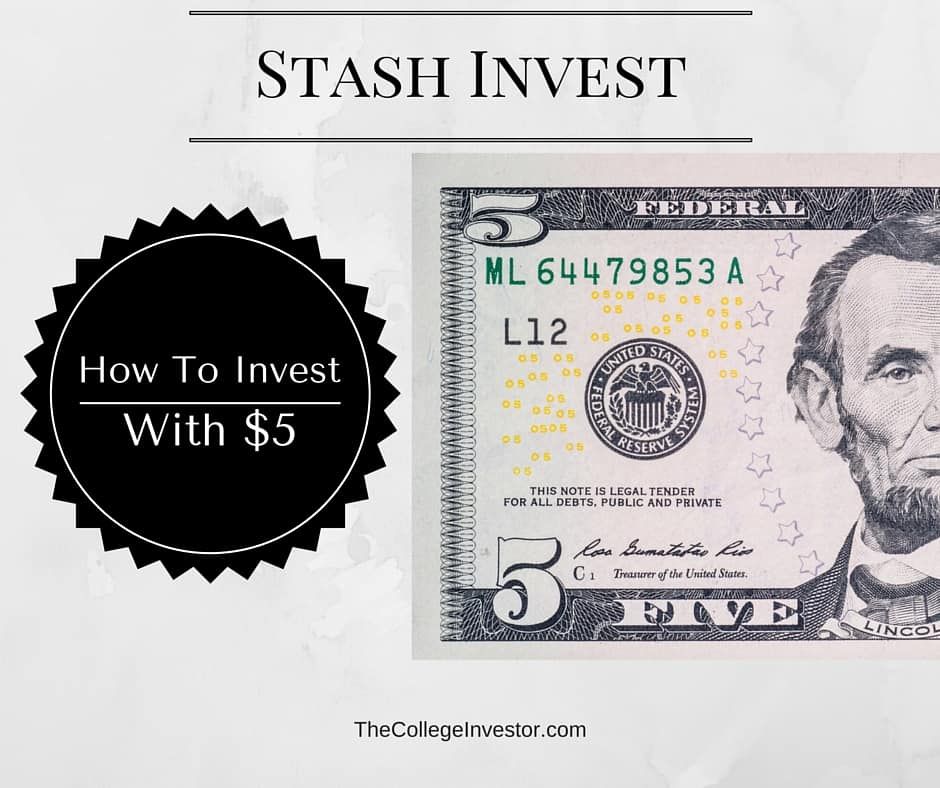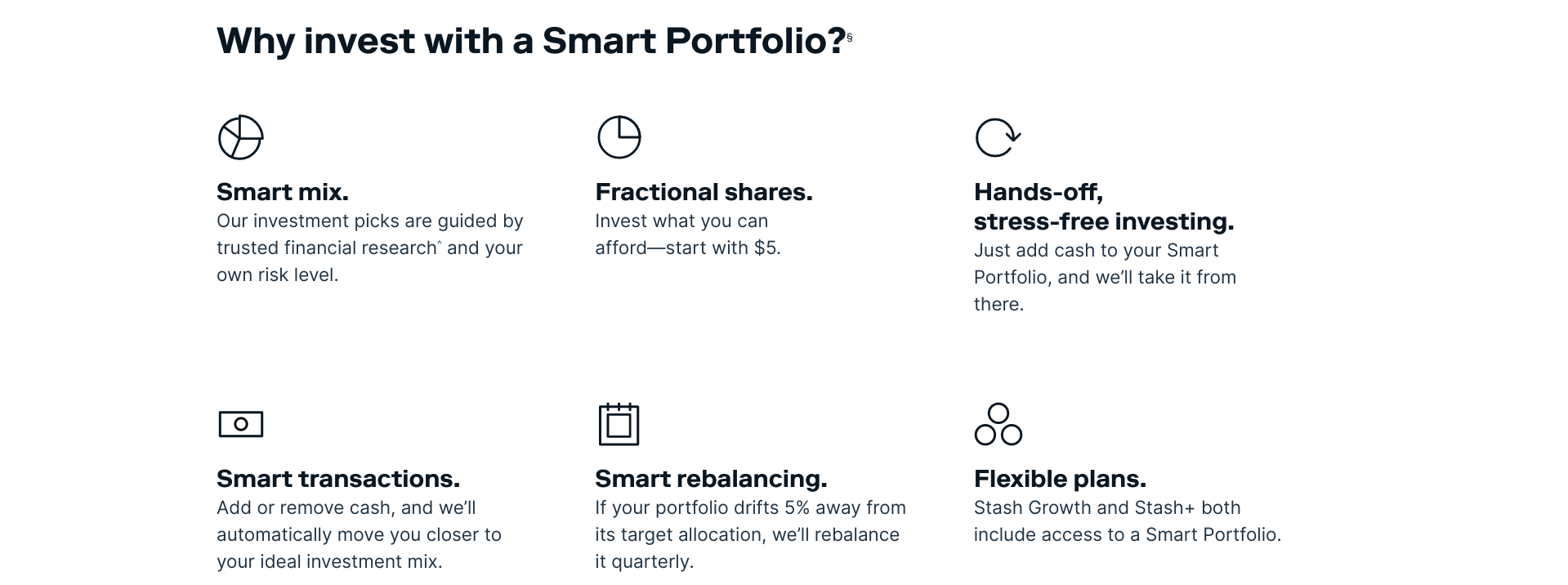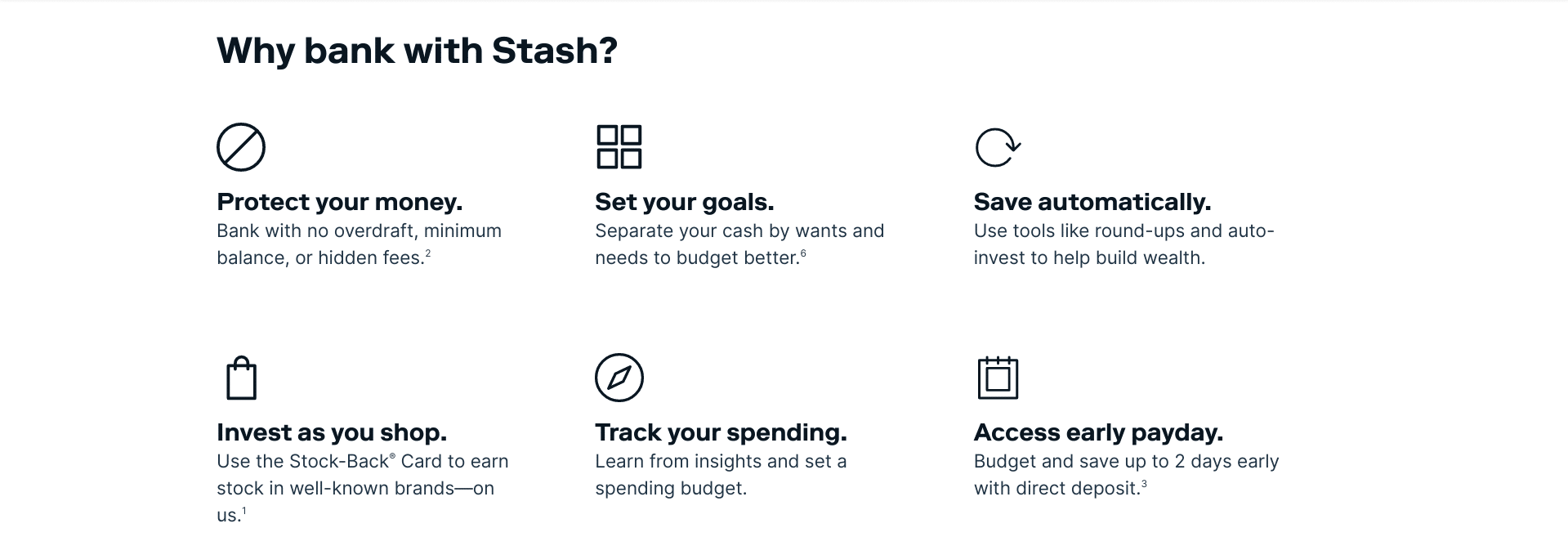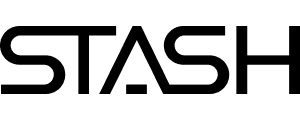
Stash is an automatic investing app that makes investing easy.
Technology has been huge for lowering investment barriers. There are now so many options that are both accessible and easy to understand by everyone.
One of these options is Stash. Stash is great because the app allows users - who perhaps don’t have a ton of money - to invest in fractional shares of a stock. With Stash, you can buy tiny percentages of stocks or ETFs with as little as $0.01¹ to $0.05.
Stash isn’t the only one offering fractional share investing. Other major brokers now have this functionality for free. So keep that in mind as you make your decision of where to invest.
Promo offer: You can get $5 from Stash when you sign up and make your first deposit of at least $5 into your Personal Portfolio! Get started here >>>
Stash Invest | |
|---|---|
Product Name | Stash |
Min Investment | No investing minimum¹ |
Subscription Fees | $3/mo or $9/mo |
Account Type | Traditional IRA, Roth IRA, Taxable, Custodial |
Promotions | Get A $5 Bonus After You Deposit $5 |
What Is Stash?
Stash is an app that launched in 2015 after the founders set out to answer the question: why don’t half of Americans invest? They kept coming back to one answer. Most people found investing to be unrelatable and intimidating.
From that premise, Stash was born. It can make it easy to automatically save money and invest it in small chunks. Plus, it includes tons of educational resources and a managed portfolio feature called Smart Portfolio for those who are looking for completely hands-off investing.
What Does It Offer?
With a beginner account, Stash members can invest in thousands of individual stocks and ETFs. Or for a higher monthly fee, you can invest with a hands-off approach called Smart Portfolio. Here's a closer look at what Stash has to offer.
Fractional Shares
Fractional Shares are available on Stash - which can be great if you're getting started with just a little bit of money. Fractional shares of most investments are available starting at $0.01. And customers can buy a piece of any stock or fund trading at more than $1,000 per share starting with just $0.05.
Smart Portfolio
If you invest at least $5 and are subscribed to the Growth or Stash+ plan, you can also invest in a Smart Portfolio. It will rebalance automatically if any of the allocations get out of alignment by more than 5%.

As customers add or remove cash, Stash will automatically move them closer to their ideal smart mix. When a customer adds cash, Stash will buy underweight investments -- and when they remove cash, Stash will sell overweight investments
Goal Planning
The goal of Stash (and any investment account) is to build your portfolio over time. Stash makes it fun and easy by creating milestones and ways to encourage you to invest more.
Stash also tries to show you your potential – by both adding new investments and teaching you the value of investing often. Over time, you can check in your home screen and see how your portfolio is doing overall.Purchasing an investment is simple. You just click on the “Add To Portfolio” button and enter how much you want to invest.
Retirement Accounts
Stash has a feature called Stash Retire, which is a retirement account option for investors. Stash Retire offers both Traditional and Roth IRAs – and offers the same investment choices you’d find in a Personal Portfolio. You can contribute up to the IRA Contribution Limit in a Stash Retire account.
Stash Retire is part of the Growth Plan and Stash+ Plan, and it costs either $3 or $9 per month.
However, this is where fees can become prohibitive. If you don’t invest more each month and see investment gains, it can start losing a percentage of your balance to your monthly subscription cost.
Banking
Stash also offers an online banking feature². The account comes with no overdraft or monthly maintenance fees³ and includes access to a large network of fee-free ATMs⁴ nationwide.

Plus, you can take advantage of the following features:
- Early Direct Deposit — customers can get their pay up to 2 days early⁵
- Stock-Back® — a rewards program where customers earn stock every time they spend⁶
- Stock Round-Ups — puts savings on auto-pilot. Every time customers spend with the Stock-Back® Card, STASH will round-up the purchases to the nearest dollar. Each time the round-ups total hits $5, STASH will transfer the spare change to the customer’s personal investment account.
Every Stash customer also receives personal guidance across every aspect of their finances. And, of course, the banking aspect connects seamlessly to Stash Invest.
What Are The Fees?
Stash currently has two pricing options - all flat-fee offerings.
- Growth — $3/mo: This plan offers a basic personal brokerage account, Stash Banking², retirement investing and unlocks Smart Portfolios. It also offers financial guidance and provides access to up to $1k of life insurance through Avibra⁷.
- Stash+ — $9/mo: This is their most robust option and is for families who want to save and invest. You'll get up to two custodial investment accounts for your children (note: these are not 529 plans). You'll also earn 2x stock with the Stock-Back® Card⁸ and the life insurance access increases to $10k.
Stash's subscription tiers start higher than Acorns which has plans at $1/mo and $3/mo. But only Stash includes banking. It should also be noted that Acorns' highest-priced plan is less expensive at $5 per month.
Important Note: Stash discontinued the Beginner ($1/mo plan) effective August 1, 2022.
How Does Stash Compare?
The biggest drawback of Stash is the cost. While $3 per month ($36 per year) may not seem like a lot, but with a small portfolio, the percentage is very high. On a $100 investment that is 36% in investing fees.
It's important to remember that self-directed accounts are available at no cost at virtually all full-service stock brokers. For this reason, I find it hard to recommend the Stash Beginner plan.
Even when you add robo-advisor service ($3/mo to $9/mo), Stash's pricing can still be high for smaller accounts when compared to robo-advisor platforms that use an AUM (assets under management) pricing model. Betterment, for example, charges 0.25% for its Digital Plan. So for a $1,000 account, you'd pay $2.50 per year with Betterment while you'd pay $36 per year for Stash Growth.
Still, some new investors may be willing to pay more to learn how to invest and form the investing habit.
However, Stash's flat-fee pricing model becomes more favorable as your account size grows. For example, at a $25,000 account balance, you'd pay Betterment $50 per year, but you'd still be paying $36 per year with Stash Growth. Here's a closer look at how Stash compares:
Header |  | ||
|---|---|---|---|
Rating | |||
Self-Directed Trading | |||
Robo-Advisor Portfolios | |||
Banking | |||
Fees | Starting at $3/mo | Starting at $0 | Starting at 0.25% |
Cell |
How Do I Open An Account?
If you want to get started with Stash, the sign-up process is extremely simple. (After you sign up check the bottom of the post for ways to quickly grow that balance.)
# 1 – Click Here To Get Started
Click here to check out Stash online and get started on your desktop.
Click here to get Stash on the App Store, you’ll be directed to the app store and you can download the app to your phone.
# 2 – Fill Out Your Profile
Next, you’ll fill out your basic information and answer a couple of questions.
These questions will help Stash guide you on making investment decisions. It’s important that you’re honest with these survey questions because they help determine your risk tolerance.
This should only take a couple of minutes.
# 3 – Choose An Investment
Based on the answers you provided, Stash will show you investment options that line up with your risk tolerance (conservative, moderate, or aggressive.) You can click on the different investments to learn more about them. (Don’t worry they’re explained in layman’s terms!)
The great thing about Stash is that they make investing relatable. Instead of crazy names of ETFs and ticker symbols, you invest in “themes” that are based on your wants, beliefs, or likes. We’ll talk more about that below.
Right now, there are thousands of investment options (stocks and funds) available on the platform.
You can invest in these for as little as $0.01¹.
4 – Link Your Bank Account
Link up the bank account you want to have money withdrawn from to make your investments.
It takes about 2-3 days for the money to transfer into Stash.
# 5 – Confirm Your Identity
Verify your identity, create a four digit pin number and you’re all done.
Is It Safe And Secure?
Yes, Stash brokerage accounts are held by Apex Clearing which is a FINRA-registered brokers. Your investments are protected up to $500,000 total by the SIPC. For details please see www.sipc.org.
For uninvested funds, your Stash account is enrolled in something called the Apex FDIC-insured Sweep Program. Deposits to the Sweep Program are covered by FDIC insurance up to $250,000 limit per customer at each FDIC-insured bank that participates in the Sweep Program. Once your cash is deposited with the participating banks under the Sweep Program, such cash will no longer be covered by SIPC. Learn about the FDIC Sweep Program.
When it comes to data security, Stash uses bank-level 256-bit encryption on its website and supports two-factor authentication (2FA) of accounts. As of writing, the company has not been connected to any hacks or data breaches.
How Do I Contact Stash?
Like other fintech platforms, Stash prefers to push its customers towards automated support options. When you visit its support page, you'll see a big button to start a conversation with its AI chatbot. But what you won't easily find is a phone number or email address.
If you look closely though you can find the company's contact information typed in small print at the bottom of the website's footer. Its customer service number is 800-205-5164 and its email address is support@stash.com.
Why Should You Trust Us?
I have been writing about and reviewing investment firms and brokerages since 2009, and have reviewed almost every US-based investment firm open to individual investors. I have seen this space evolve from high cost to low cost options, and have seen the amount of investment tools grow for individuals.
Furthermore, we have been polling our audience for years to find out which investment firms they trust and use, and that's how we put together our annual rankings of the best investment companies.
Finally, we have our compliance team that regularly checks and updates the facts on our reviews.
Who Is This For And Is It Worth It?
If you've been putting off investing for your future due to lack of knowledge or motivation, consider Stash. Its automatic investment tools and educational resources could really help to jump-start your investing journey.
But you'll probably want to consider other options if you're an experienced and cost-conscious investor. For every investing style, there's likely a cheaper solution.
Stash FAQs
Here are a few of the most common questions people ask about Stash:
Does Stash make you money?
It can. Stash banking customers who use the Stock-Back® Card² will earn up to 1%⁸ stock back on all of their everyday purchases and up to 2% in at certain retailers⁶. It gives away pieces of stocks to members who attend Stash Stock Parties.
Can you try Stash at no cost?
You can try out your first month of the Stash plan you choose on them – you can also receive a $5 bonus into your Personal Portfolio after you deposit at least $5 by clicking here.
Can you buy mutual funds with Stash?
No, but you can invest in diversified and low-cost ETFs (exchange-traded funds).
Does Stash offer margin trading?
No, Stash does not allow any of its members, regardless of their subscription tier, to trade on margin.
Can you buy crypto on Stash?
No, cryptocurrency is not currently a supported asset. Stash does say, however, that it's looking into adding crypto investing to its platform in the future.
Stash Features
Account Types |
|
Tradable Assets |
|
Account Minimum | No investing minimums¹ |
Commissions | $0 |
Account Fees |
|
Automatic Rebalancing | Yes |
Tax-Loss Harvesting | No |
Access To Human Advisors | No |
Margin Trading | No |
Banking Services | Yes |
Customer Service Number | (800) 205-5164 |
Customer Service Email | support@stash.com |
Web/Desktop Account Access | Yes |
Mobile App Availability | iOS and Android |
Promotions | Get a $5 bonus after your first deposit of $5 |
DISCLAIMER
Nothing in this material should be construed as an offer, recommendation, or solicitation to buy or sell any security. All investments are subject to risk and may lose value.
Paid non-client endorsement. See Apple App Store and Google Play reviews. View important disclosures.
Nothing in this material should be construed as an offer, recommendation, or solicitation to buy or sell any security. All investments are subject to risk and may lose value.
Cryptocurrency trading and execution services are provided by Apex Crypto LLC (NMLS ID 1828849) through a software license agreement between Apex Crypto LLC and Stash Financial, Inc. Apex Crypto is not a registered broker-dealer or a member of SIPC or FINRA and is licensed to engage in virtual currency business activity by the New York State Department. Cryptocurrencies are not securities and are not FDIC or SIPC insured. Advisory products and services are offered through Stash Investments LLC, an SEC registered investment adviser. Cryptocurrency is a highly volatile investment; please ensure that you fully understand the risks involved before trading crypto. Visit apexcrypto.com/legal. Apex Crypto charges customers a fee on each cryptocurrency transaction based on their subscription plan with Stash, a portion of which Stash receives as revenue.
1 Fractional shares start at $0.05 for investments that cost $1,000+ per share.
2 Stash Banking services provided by Stride Bank, N.A., Member FDIC. The Stash Stock-Back® Debit Mastercard® is issued by Stride Bank pursuant to license from Mastercard International. Mastercard and the circles design are registered trademarks of Mastercard International Incorporated. Any earned stock rewards will be held in your Stash Invest account. Investment products and services provided by Stash Investments LLC, not Stride Bank, and are Not FDIC Insured, Not Bank Guaranteed, and May Lose Value. In order for a user to be eligible for a Stash banking account, they must also have opened a taxable brokerage account on Stash.
3 Other fees apply to the bank account. Please see the Deposit Account Agreement for details. If applicable, your Stash banking account is a funding account for purposes of the Advisory Agreement. Your Stash subscription fee may be deducted from your Stash banking account balance.
4 Get fee-free transactions at any Allpoint ATM, see the app for location details, otherwise out-of-network ATM fees may apply. For a complete list of fees please see the Deposit Account Agreement for details.
5 Early access to direct deposit funds depends on when the payor sends the payment file. We generally make these funds available on the day the payment file is received, which may be up to 2 days earlier than the scheduled payment date.
6 All rewards earned through use of the Stash Stock-Back® Debit Mastercard® will be fulfilled by Stash Investments LLC. You will bear the standard fees and expenses reflected in the pricing of the investments that you earn, plus fees for various ancillary services charged by Stash. In order to earn stock in the program, the Stash Stock-Back® Debit Mastercard must be used to make a qualifying purchase. What doesn’t count: Cash withdrawals, money orders, prepaid cards, and P2P payment. If you make a qualifying purchase at a merchant that is not publicly traded or otherwise available on Stash, you will receive a stock reward in an ETF or other investment of your choice from a list of companies available on Stash. Stock rewards that are paid to participating customers via the Stash Stock Back program, are Not FDIC Insured, Not Bank Guaranteed, and May Lose Value. Stash reserves the right to amend this program and the terms and conditions thereof and/or cancel this program at any time, for any reason, upon notice to you. See Terms and Conditions for more details.
7 Group life insurance coverage provided through Avibra, Inc. Stash is a paid partner of Avibra. Only individuals who opened Stash accounts after 11/6/20, aged 18-54 and who are residents of one of the 50 U.S. states or DC are eligible for group life insurance coverage, subject to availability. Individuals with certain pre-existing medical conditions may not be eligible for the full coverage above, but may instead receive less coverage. All insurance products are subject to state availability, issue limitations and contractual terms and conditions, any of which may change at any time and without notice. Please see Terms and Conditions for full details. Stash may receive compensation from business partners in connection with certain promotions in which Stash refers clients to such partners for the purchase of non-investment consumer products or services. This type of marketing partnership gives Stash an incentive to refer clients to business partners instead of to businesses that are not partners of Stash. This conflict of interest affects the ability of Stash to provide clients with unbiased, objective promotions concerning the products and services of its business partners. This could mean that the products and/or services of other businesses, that do not compensate Stash, may be more appropriate for a client than the products and/or services of Stash’s business partners. Clients are, however, not required to purchase the products and services Stash promotes.
8 1% Stock-Back® rewards available only on Stash+ ($9/mo) and only for client’s first $1,000 of Qualifying Purchases in each calendar month program. See Terms and Conditions for details.
Offer is subject to T&Cs. You must complete within the specific time period included in this offer: (i) successfully complete (or already have completed, or re-apply for and complete) the registration process of opening an individual taxable brokerage account (“Personal Portfolio”), (ii) link a funding source to your account; AND (iii) deposit at least $5 from your funding source into your Personal Portfolio. *T&Cs
Stash Subscription fee starts at $3/ month. You’ll also bear the standard fees and expenses reflected in the pricing of the ETFs in your account, plus fees for various ancillary services charged by Stash and the Custodian. Please see the Advisory Agreement for details. Other fees apply to the bank account. Please see the Deposit Account Agreement.
A “Smart Portfolio” is a Discretionary Managed account whereby Stash has full authority to manage.
Stash Review
-
Commissions & Fees
-
Customer Service
-
Ease Of Use
-
Tools & Resources
-
Investing Options
-
Specialty Services
Overall
Summary
Stash allows investors to automatically invest in fractional shares of stocks and ETFs as well as in Smart Portfolios.
Pros
- Makes investing easy to understand
- Supports fractional share investing
- Smart Portfolios include automatic rebalancing
- Earn stock with the Stock-Back® card⁶
Cons
- Fees can be high as a percentage of your assets
- Only supports stock and ETF investments

Robert Farrington is America’s Millennial Money Expert® and America’s Student Loan Debt Expert™, and the founder of The College Investor, a personal finance site dedicated to helping millennials escape student loan debt to start investing and building wealth for the future. You can learn more about him on the About Page or on his personal site RobertFarrington.com.
He regularly writes about investing, student loan debt, and general personal finance topics geared toward anyone wanting to earn more, get out of debt, and start building wealth for the future.
He has been quoted in major publications, including the New York Times, Wall Street Journal, Washington Post, ABC, NBC, Today, and more. He is also a regular contributor to Forbes.
Editor: Clint Proctor Reviewed by: Ashley Barnett